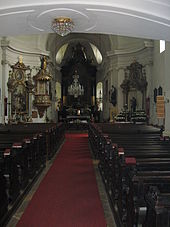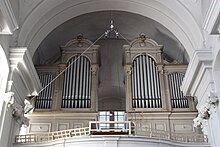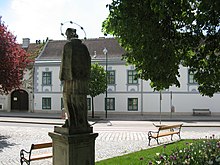Parish church Oberlaa
The Church of St. Aegydius is the Roman Catholic parish church of Oberlaa and is located on Oberlaaer Platz in the 10th Viennese district of Favoriten . The parish belongs to City Deanery 10 of the Archdiocese of Vienna . The church has 5 bells in the tones c ″ e ″ h ′ gis ′ e ′, which were cast by Pfundner in Vienna.
history
There is evidence of a church in Oberlaa as early as 1267. It has been a parish church since around 1324. Destroyed during the second Turkish siege of Vienna in 1683, initially only a makeshift reconstruction took place. It was not until the years 1744–1746 that Mathias Gerl built today's church in the Baroque style .
Outside
The southern facade with the gate and a bell tower with an onion dome dominates the outside . On the facade, which is structured by pilasters and volutes, the figures of the apostles Peter and Paul by Philipp Anton Höller from 1744 to 1745 are located in niches. On the outside of the apse facing north is the classical tomb of Joseph Ritter von Vallemary.
Furnishing
The interior consists of the main altar by Sebastian Haupt from around 1759. The high altar painting of St. Giles comes from Johann Zimbal. The picture on the right side altar, also created by Johann Zimbal, depicts St. Sebastian (1749), in the excerpt there is an oval picture with St. Catherine of Alexandria . The image with Saint Barbara stands in a splendid baroque frame . On the left side altar you can see the image of the Holy Trinity , probably also from Zimbal, in the excerpt an oval picture with St. Apollonia and a showcase with a copy of Mariazell's Mother of Grace.
The pulpit was created by Johann Tabotta around 1760. It is richly adorned with gilded decoration and has a curved basket with a sound cover. This is crowned by the figure of St. John the Evangelist and an eagle with an inkwell in its beak.
Other works of art in the church are the figures of St. Florian and St. Donatus from the middle of the 18th century, a Madonna figure of Mary of Victory with child from the fever chapel in Rothneusiedl (around 1709), a small altar with wooden figures (around 1700), and the figures of St. Joseph with child and St. Anthony of Padua from the 19th century. Paintings depict the Sorrows of Mary (around 1730), St. John Nepomuk , a Madonna and Child (19th century in a frame around 1720), St. Anna teaching Mary to read, and St. Joseph in a frame with banded top around 1720, religious saint in 2 oval pictures from the 3rd quarter of the 18th century, Saint Leonhard and Saint Leopold (both end of the 18th century). The Way of the Cross was created in 1849 by Anton Böhm.
The pews are from the construction time. A communion bench made of red and black marble is also baroque.
In the sacristy there is a cabinet from the construction period and a crucifix, also from the 18th century. The baptismal font in the baptistery comes from Joseph Allbrecht and was made of red marble in 1777. There is also a Nazarene picture of the Man of Sorrows from the mid-19th century.
organ
The organ was built by Matthäus Mauracher in 1903. The 15 registers on two manuals and pedal operative instrument is provided with slopes valve shop and pneumatic game - and key action feature. Their housing shows itself in neo-renaissance forms .
|
|
|
|||||||||||||||||||||||||||||||||||||||||||||||||||||||||||||||||||||||||||||||||||||||||||||
Church square
On the green, park-like church forecourt stands the baroque statue of St. John Nepomuk with a crucifix and a martyr's palm in his hands, on the head the biretta with a star wreath (1754) on a four-sided stone base. It was restored by Heribert Rath in 1978.
To the left of the church is a war memorial that was created in 1924 by the sculptor Heinrich Scholz based on a design by Ladewig. In the middle is the figure of a soldier, to the right and left of it inscription panels with the names of the fallen soldiers of the First and Second World Wars from Oberlaa.
Rectory
Opposite the church at Oberlaaer Platz 3 is the rectory, which consists of 2 eaves two-storey houses. The core of the western part dates from the beginning of the 17th century and was changed in 1735 by a beautiful arched entrance, the eastern part was rebuilt in the second half of the 18th century. The windows have wedge-shaped frames and fluted curved sills , the facade painting has been renewed.
Folklore
Every year on April 25th, the St. Mark's procession takes place, during which people pray for a good wine harvest. This procession leads from the Oberlaa parish church over An der Kuhtrift to the Schmerber Cross , on to the Red Cross , to the Pietà chapel and back to the parish church in Oberlaa.
literature
- 200 years parish church of St. Aegydius in Oberlaa . 1959
- Erhard Kreuzer: The parish church of Oberlaa and the branch churches in Unterlaa and Rothneusiedl . 1973
- Herbert Tschulk: Viennese district culture guide favorites . Youth & People: Vienna 1985
- Felix Czeike : Historisches Lexikon Wien Vol. 4. Kremayr & Scheriau: Wien 1995
- Federal Monuments Office (ed.): Dehio-Handbuch Wien. X. to XIX. and XXI. to XXIII. District. Anton Schroll: Vienna 1996
Web links
Individual evidence
- ↑ References: 2001-2010. bodem.at, accessed on August 17, 2013 .
- ↑ Information on the organ
- ↑ On the Kuhtrift = street name in Favoriten, named since June 9, 1987 after the name of this area at the time, on the southwestern edge of today's Oberlaa spa park
- ^ Schubert: Favorites. Verlag Bezirksmuseum Favoriten , 1992; P. 34
Coordinates: 48 ° 8 ′ 16.5 ″ N , 16 ° 24 ′ 15.6 ″ E




